
Alfonso Jordan, also spelled Alfons Jordan or Alphonse Jourdain (1103–1148), was the Count of Tripoli (1105–09), Count of Rouergue (1109–48) and Count of Toulouse, Margrave of Provence and Duke of Narbonne (1112–48).

The Albigensian Crusade, also known as the Cathar Crusade (1209–1229), was a military and ideological campaign initiated by Pope Innocent III to eliminate Catharism in Languedoc, what is now southern France. The Crusade was prosecuted primarily by the French crown and promptly took on a political aspect. It resulted in the significant reduction of practicing Cathars and a realignment of the County of Toulouse with the French crown. The distinct regional culture of Languedoc was also diminished.

Raymond of Saint-Gilles, also called Raymond IV of Toulouse or Raymond I of Tripoli, was the count of Toulouse, duke of Narbonne, and margrave of Provence from 1094, and one of the leaders of the First Crusade from 1096 to 1099. He spent the last five years of his life establishing the County of Tripoli in the Near East.
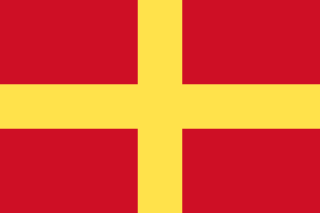
The County of Tripoli (1102–1289) was one of the Crusader states. It was founded in the Levant in the modern-day region of Tripoli, northern Lebanon and parts of western Syria. When the Frankish Crusaders, mostly southern French forces – captured the region in 1109, Bertrand of Toulouse became the first count of Tripoli as a vassal of King Baldwin I of Jerusalem. From that time on, the rule of the county was decided not strictly by inheritance but by factors such as military force, favour and negotiation. In 1289, the County of Tripoli fell to the Muslim Mamluks of Cairo under Sultan Qalawun, and the county was absorbed into Mamluk Sultanate.

The County of Toulouse was a territory in present-day southern France consisting of the city of Toulouse and its environs, ruled by the Count of Toulouse from the late 9th century until the late 13th century.
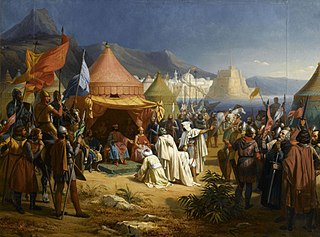
Bertrand of Toulouse was count of Toulouse, and was the first count of Tripoli to rule in Tripoli itself.
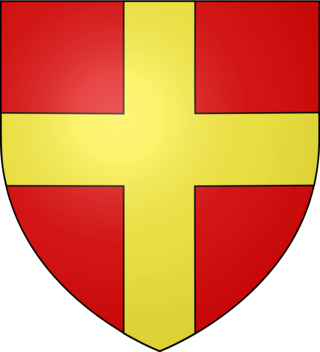
The count of Tripoli was the ruler of the County of Tripoli, a crusader state from 1102 through to 1289. Of the four major crusader states in the Levant, Tripoli was created last.
The count of Toulouse was the ruler of Toulouse during the 8th to 13th centuries. Originating as vassals of the Frankish kings, the hereditary counts ruled the city of Toulouse and its surrounding county from the late 9th century until 1270. The counts and other family members were also at various times counts of Quercy, Rouergue, Albi, and Nîmes, and sometimes margraves of Septimania and Provence. Count Raymond IV founded the Crusader state of Tripoli, and his descendants were also counts there. They reached the zenith of their power during the 11th and 12th centuries, but after the Albigensian Crusade the county fell to the kingdom of France, nominally in 1229 and de facto in 1271.
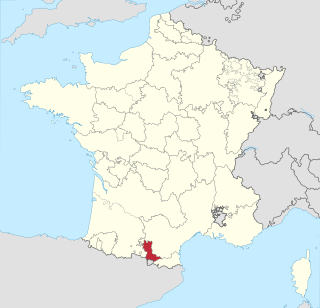
The County of Foix was a medieval fief in southern France, and later a province of France, whose territory corresponded roughly the eastern part of the modern département of Ariège.

Raymond VI was Count of Toulouse and Marquis of Provence from 1194 to 1222. He was also Count of Melgueil from 1173 to 1190.

Saint-Antonin-Noble-Val is a commune in the Tarn-et-Garonne department in the Occitanie region in southern France.
The County of Carcassonne was a medieval fiefdom controlling the city of Carcassonne, France, and its environs. It was often united with the County of Razès.

The Ramnulfids, or the House of Poitiers, were a French dynasty of Frankish origin ruling the County of Poitou and Duchy of Aquitaine in the 9th through 12th centuries. Their power base shifted from Toulouse to Poitou. In the early 10th century, they contested the dominance of northern Aquitaine and the ducal title to the whole with the House of Auvergne. In 1032, they inherited the Duchy of Gascony, thus uniting it with Aquitaine. By the end of the 11th century, they were the dominant power in the southwestern third of France. The founder of the family was Ramnulf I, who became count in 835.
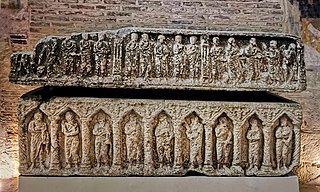
William III Taillefer was the Count of Toulouse, Albi, and Quercy, as well as the Marquis of Gothie from 972 or 978 to his death. He was the first of the Toulousain branch of his family to bear the title marchio, which he inherited from Raymond II of Rouergue.
Raymond I was the Count of Limoges, Rouergue and Quercy, and Toulouse and Albi. He was the younger son of Fulcoald of Rouergue and Senegund, niece of William of Gellone through his sister Alda.
Fulcoald, Foucaud, Fulguald or Fulqualdus is sometimes called the Count of Rouergue and founder of that dynasty of counts which ruled Toulouse and often all of Gothia for the next four centuries. In 837, he was appointed missus dominicus along with Ragambald in the pago Rutenico seu Nemausense: country of Rouergue and Nîmes.
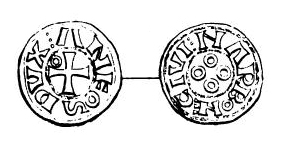
The title Duke of Narbonne was a title employed at various times by the overlords of Narbonne, while the direct power in the city was held by the viscounts. The prestige of the title probable attached to the fact that Narbonne had been a capital of the ancient Roman administration of the eponymous province of Gallia Narbonensis.
The County of Rodez was a fief of the County of Toulouse formed out of part of the old County of Rouergue in what is today Aveyron, France. Its capital was Rodez. At its height, it was a centre of troubadour culture.
The army of Raymond of Saint-Gilles was one of the first to be formed after Pope Urban II called for the First Crusade. Raymond formed a Provençal army and left his County of Toulouse in October 1096, traveling over the land route. He was the only leader of a major army that did not swear an oath of fealty to Byzantine emperor Alexius I Komnenos.
Raymond I of Turenne was the 7th Viscount of Turenne. He participated along with his vassals in the First Crusade as part of the Army of Raymond of Saint-Gilles.
















